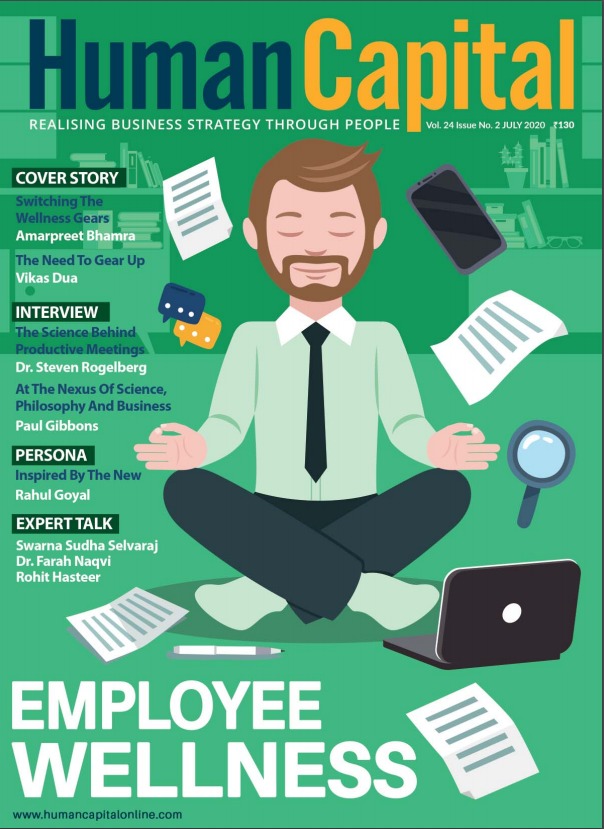While COVID-19 has not prevented us from living our lives or doing business, it has changed the way we think, act, and interact. It has altered our way of life and the way we do business.
In the month of March this year, most HR professionals were focused on performance and reward management cycles. Growth areas were being discussed for Annual Operating plans. Offsite location booking was underway to hold an annual meeting. There was an urgency to complete face to face feedback and expectation setting meetings.
Suddenly everything changed. Face to face meetings became online meetings. Discussions on growth areas drifted towards survival strategies. Focus shifted from performance management to health and safety. One invisible virus changed the world on a drastic scale.
While COVID-19 has not been able to prevent us from living our lives or from doing business, it still has changed the way we think, the way we act, the way we interact, the way we live our lives and the way we do business.
Need to Review
After working in the lockdown for a few months, businesses have accepted that work can happen from home. There are bright chances that part of the workforce for most organisations will continue to work from home post COVID-19. One reason will be cost, another will be accessibility to better talent across geography, and the third, possibly, will be flexibility to use various engagement models.
Work from home looks good. However, this is only the honeymoon period. If you want it to work for you in the long run, then you need to review your policies in context of the new normal. Here are the top 5 policies (areas) which I would strongly recommend that you review in the context of your business.
1. Work From Home (Remote Work) Policy
Figure out some of the elements of work from home to avoid confusion and conflicts in future.
a. Location: Be on the same page with the employees, where the employees can work from. Will you be comfortable with your employees working from their home, or rather, their hometown? If an employee works from her hometown (which is different from your business location), just check that you are ensuring compliances based on the right location. Compliances may include professional tax, ESIC, holiday calendar, leaves etc.
First, answer these three questions (in terms of employer OR employee)
i. Who will acquire the assets in question?
ii. Who will maintain said assets?
iii. Who will pay the utility bills for the employee’s internet and electricity?
Secondly, you need to decide who will pay for it. There are several options
i. Employee (the same way employee pays for transportation to work at many companies)
ii. Company (Cost of doing business)
iii. Part company (up to a certain amount), Part employee
iv. Initially paid for by the employee, reimbursed over a period of time by company
c. Confidentiality: Set clear expectations with the employee to decide whether the employee has to set up a home office (designated place in the house) OR if the employee can operate from a coffee shop (depending on the information being handled by your employees). It will be a good idea to introduce Non-Disclosure Agreements and social media guidelines, clearly articulating what is acceptable and what is not. However, merely endorsing a policy does not serve the purpose. Ensure pointers are communicated in your induction programmes and are emphasised by front line managers.
2. Leave and Attendance Policy
a. Monitor Time or Monitor work: Scope of Leave and Attendance policy is a lot wider than it seems. If a part of your workforce is working remotely, then think carefully whether you still want to monitor time for a job role or you want to shift to monitoring productivity instead.
b. How to monitor time: If you choose to monitor time, you need to define the method to capture time. It can be a simple tool to mark in and out time. You may choose to use geofencing for it. Same can be achieved by monitoring login and logout time on the system of work, so that no attendance system is required. You can be as creative as you want.
c. Dealing with down time: In case you have made your choices regarding a “work from home” infrastructure, you need to be on the same page with the employee on one crucial point. For instance, if the employee is not available due to any infrastructural issues (power, connectivity or device breakdown), will you be asking the employee to apply for leave or pay full wages for the period.
3. Recruitment and Onboarding Policy
a. Talent Pool: Review recruitment guidelines, considering that work can be done from anywhere. Sensitize recruiters and managers to go beyond geographical boundaries. You may end up hiring better talent, and at the same time cost of living in smaller towns can improve the bottom line.
b. Pre-Employment Medical and Background Verification: Review your pre-employment medical checks, whether you need to add a few checks or rationalize. You must review the checks you are conducting for background verification.
c. Digital on-boarding Definition: If you are not hung on to a location, you might consider digital onboarding. All the paperwork can be digital. However, make up your mind, when you will call a person digitally on-boarded. It can be any of the following or a combination:
i. When the person is available to work
ii. When the person is enabled to work
iii. When the person is allocated work
The definition alone will give you return on investment. You may review various aspects of on-boarding. These can be simple things like whether you want to do their induction before or after joining. Or perhaps, is there a need to provide a physical Identity card to the employee? Many companies convey their warmth through joining kits, and it will be interesting to see how companies manifest their warmth in the digital equivalent of the same.
4. Engagement Policy
a. Feel the pulse: Engagement is a bigger challenge in a digital environment because you cannot walk the floor and feel the pulse anymore. To avoid surprises, figure out a method. There are multiple ways available including digital surveys and people behaviour analytics. You need to invest in some digital tools and establish methods and practices to be on top of it.
b. Team Building: Review the engagement budgets and team outing policies. Think how you want to spend that money judiciously. Do not try to save money here, rather try to invest money to derive the same outcome in a virtual environment.
5. Health and Safety Policy
COVID-19 may not be that dangerous, but the treatment is expensive. Review your health and safety policy for adequate coverage of employees. Also plan for programmes through your insurance service provider on mental health, you will not regret it!
Follow and connect with us on LinkedIn, Facebook, Instagram, Twitter for latest HR news and insights.
Do you look forward to permanently working from home after the pandemic subsides?
Trending
-
SBI General Insurance Launches Digital Health Campaign
-
CredR Rolls Out 'Life Happens' Leave For Its Employees
-
Meesho Announces 30-Week Gender-Neutral Parental Leave Policy
-
Microsoft Unveils Tech Resilience Curriculum To Foster An Inclusive Future
-
60% Indian Professionals Looking For Job Change Due To COVID: Survey
-
SpringPeople And Siemens Collaborate For Digital Transformation Push
-
86% Professionals Believe Hybrid Work Is Essential For Work Life Balance: Report
-
Almost 1 In Every 3 People's Personal Life Affected Due To Work Stress
-
Meesho Rolls Out Reset And Recharge Policy For Employees
-
80% Of Talent Leaders & Academics Say Pandemic Changed Skill Needs For Youth: Report
-
Hero Electric Rolls Out 'Hero Care' Program For Employees
-
Human Capital In Collaboration With ASSOCHAM Hosts Virtual Conference
-
IKEA India, Tata STRIVE Collaborate To Create Employability And Entrepreneurship Opportunities
-
SAP India, Microsoft Launch Tech Skilling Program for Young Women
-
DXC Technology, NASSCOM Collaborate For Employability Skills Program
-
Lenskart To Hire Over 2000 Employees Across India By 2022
-
Mindtree Launches Learn-and-Earn Program
-
Tata AIA Extends 'Raksha Ka Teeka' To Its Employees
-
Swadesh Behera Is The New CPO Of Titan
-
NetConnect Global Plans To Recruit 5000 Tech Professionals In India
-
Hubhopper Plans To Hire 60% Of Indian Podcasters By 2022
-
Corporate India Needs More Women In Leadership Roles: Report
-
Aon to Invest $30 Million and Create 10,000 Apprenticeships by 2030
-
Tech Mahindra Launches ‘Gift a Career’ Initiative for Upskilling of Youth
-
40% Women Prefer Flexible Working Options in Post-COVID World: Survey
-
3 out of 4 companies believe they can effectively hire employees virtually: Report
-
Vodafone , CGI and NASSCOM Foundation launch digital skills platform
-
Odisha: Bank, postal employees to deliver cash for elderly, differently-abled persons
-
Skill India launches AI-based digital platform for "Skilled Workforce"
-
Hiring activity declines 6.73% in first quarter: Survey
-
70% startups impacted by COVID-19 pandemic
-
Bajaj Allianz Life ropes in Santanu Banerjee as CHRO
-
Over 70 Percent MSMEs look at cutting jobs to sustain businesses
-
93 Per Cent employees stressed about returning to office post-lockdown
-
Johnson & Johnson India announces family benefits for same gender partners
-
Indian firms turning friendly towards working mothers
-
Welspun India names Rajendra Mehta as new CHRO
-
Wipro partners with NASSCOM to launch Future Skills platform



Human Capital is niche media organisation for HR and Corporate. Our aim is to create an outstanding user experience for all our clients, readers, employers and employees through inspiring, industry-leading content pieces in the form of case studies, analysis, expert reports, authored articles and blogs. We cover topics such as talent acquisition, learning and development, diversity and inclusion, leadership, compensation, recruitment and many more.
Subscribe Now












































Comment